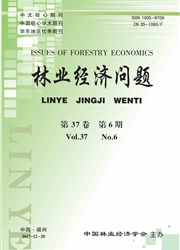

 中文摘要:
中文摘要:
基于浙江省5个县(市)21个行政村的211户农户调查数据,采用实验经济学的方法测度农户风险偏好,利用多元回归模型实证分析了碳汇经营目标下农户风险偏好对延长轮伐期的影响。研究结果表明:风险偏好变量在10%的水平下具有显著的正面影响;家庭年总收入变量在5%的水平下具有显著的正面影响;林地面积和林地与村委会海拔高度在10%的水平下具有显著的正面影响;地块分散程度、林地实际经营面积和阳坡林地所占比例在10%的统计水平下具有显著的负面影响。在其他条件不变的情况下,拥有较高家庭年总收入的高风险偏好者和不经营的林地面积大且较为集中的高海拔阴面林地更倾向于延长轮伐期投入到长期的碳汇收益中来。根据研究结果,提出了对风险厌恶和风险中性的农户给予适当激励;在碳汇项目选择和实施过程中需要考虑地块质量和农户基本特征的问题;建立健全林地流转体系,增加林地规模效应;建立方便快捷的碳汇评估交易平台,增强农户碳汇供给动力等针对性的建议。
 英文摘要:
英文摘要:
The paper measured the risk preference of rural households by the means of Experimental Economics.The multiple regression model with empirical evidence of which data comes from 211 households in 21 different villages of 5 different counties analysis the influences of rural households' risk preference for extend rotation in the objective of carbon sequestration.The research indicates a positive impact on the risk preference at the significance level of 0.1.The family income and the forest land shows a positive impact at the significance level of 0.05 while the forest land and the altitude of forest land with the committee in the village both show a positive impact at the significance level of 0.1.Furthermore,the level of land dispersion,areas of practically managing forest land and the adret slope show a negative impact at the significance level of 0.1.In equal conditions,the rural households with higher income and risk preference are more likely to participate in the long run management of carbon sequestration as well as those who owe larger areas of forest land and massed ubac at high altitudes.According to the results,this paper puts forward some specific recommendations such as giving incentives to risk neutral and risk aversion people,considering the quality of lands and basic features of households when funding the carbon sequestration projects,optimizing the land transfer system to increase scale effect and establishing the convenient evaluate and trading platform to increase the motivation of carbon sequestration's supply.
 同期刊论文项目
同期刊论文项目
 同项目期刊论文
同项目期刊论文
 期刊信息
期刊信息
